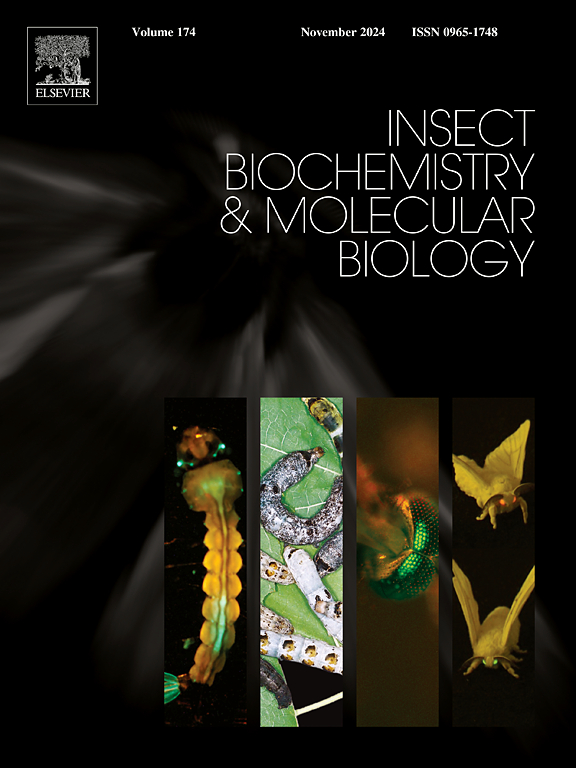埃及伊蚊吸血后、氯菊酯暴露后和生命周期内氨基酸和酰基肉碱谱。
IF 3.7
2区 农林科学
Q2 BIOCHEMISTRY & MOLECULAR BIOLOGY
引用次数: 0
摘要
埃及伊蚊是虫媒病毒的主要传播媒介,由于对杀虫剂的抗药性不断增强,需要采取有效的控制策略。本研究测定了2株伊蚊的12个氨基酸和24个酰基肉碱。埃及伊蚊(新奥尔良,易感;采用串联质谱法(MS/MS)对三种方法进行分析:1)生命周期阶段,2)空腹和血后喂养(24、48、72小时),以及3)氯菊酯暴露前后。在整个生活史中,雄成虫的丙氨酸含量最高(40.3%),雌成虫的精氨酸含量最高(18.35%),酪氨酸含量最高(14.74%)。酰基肉碱C0(游离肉碱)含量在第4期最高(94.21%),成虫C2(乙酰肉碱)含量最高(47.68%)。血喂养后,Ala在72 h达到峰值(43.34%),脯氨酸(Pro)在48 h达到峰值(20.63%),Arg从0 h(18.35%)下降到72 h(11.15%)。酰基肉碱C0和C2在饲喂后呈下降趋势,表明脂肪酸动员。氯菊酯暴露后,抗性蚊子的Ala(51.7%)和C2(57.9%)水平升高,表明其解毒代谢活性增加。相比之下,易感蚊子的氨基酸和酰基肉碱水平变化较小。这些结果为伊蚊的代谢适应提供了有价值的见解。这表明针对氨基酸和酰基肉碱途径改进病媒控制策略的潜力,特别是在杀虫剂耐药性不断上升的背景下。本文章由计算机程序翻译,如有差异,请以英文原文为准。

Amino acid and acylcarnitine profile of Aedes aegypti (L) post-blood feeding, after permethrin exposure, and during the life cycle
Aedes aegypti, a major vector for arboviruses, requires effective control strategies due to rising insecticide resistance. This study quantified 12 amino acids and 24 acylcarnitines in two strains of Ae. aegypti (New Orleans, susceptible; Apodaca, resistant) using tandem mass spectrometry (MS/MS) across three approaches: 1) life cycle stages, 2) fasting and post-blood feeding (24, 48, 72 h), and 3) before and after permethrin exposure. In the life cycle, alanine (Ala) was highest in adult males (40.3 %), arginine (Arg) peaked in adult females (18.35 %), and tyrosine (Tyr) reached 14.74 % in larvae. The acylcarnitine C0 (free carnitine) peaked in larvae stage 4 (94.21 %), while C2 (acetyl carnitine) was highest in adult females (47.68 %). Post-blood feeding, Ala peaked at 72 h (43.34 %), proline (Pro) at 48 h (20.63 %), and Arg decreased from 0 h (18.35 %) to 72 h (11.15 %). Acylcarnitines C0 and C2 showed a decline post-feeding, indicating fatty acid mobilization. After permethrin exposure, resistant mosquitoes exhibited higher Ala (51.7 %) and C2 (57.9 %) levels, suggesting increased metabolic activity for detoxification. In contrast, susceptible mosquitoes displayed less variability in amino acid and acylcarnitine levels. These results provide valuable insights into the metabolic adaptations of Ae. aegypti, indicating the potential for targeting amino acid and acylcarnitine pathways to improve vector control strategies, particularly in the context of rising insecticide resistance.
求助全文
通过发布文献求助,成功后即可免费获取论文全文。
去求助
来源期刊
CiteScore
7.40
自引率
5.30%
发文量
105
审稿时长
40 days
期刊介绍:
This international journal publishes original contributions and mini-reviews in the fields of insect biochemistry and insect molecular biology. Main areas of interest are neurochemistry, hormone and pheromone biochemistry, enzymes and metabolism, hormone action and gene regulation, gene characterization and structure, pharmacology, immunology and cell and tissue culture. Papers on the biochemistry and molecular biology of other groups of arthropods are published if of general interest to the readership. Technique papers will be considered for publication if they significantly advance the field of insect biochemistry and molecular biology in the opinion of the Editors and Editorial Board.

 求助内容:
求助内容: 应助结果提醒方式:
应助结果提醒方式:


